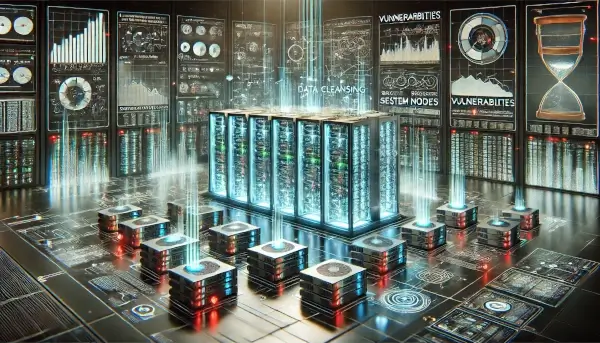
If your business relies on data for decision-making, you'll know how important data cleansing is. But it's not just a key part of gaining accurate and reliable insights — it's also important for security. We'll look at what data cleansing is, how it relates to vulnerability monitoring, and how to get started.
Table of Contents:
What is data cleansing?
What is vulnerability monitoring?
How data cleansing helps vulnerability monitoring
Types of data cleansing by application
How to scrub your data effectively
Conclusion
What is data cleansing?

Companies collect a lot of data daily — from customers, the wider market, suppliers, and other sources. Once this data has been collected, it needs to be stored and cleaned up. Data cleansing is the process of identifying things like inaccuracies, entry mistakes, and irrelevant or out-of-date information and then removing or replacing them.
An enterprise business would need a small army to do this manually. That's why automated data monitoring and cleansing have become an everyday AI use in business. Automated analytics tools can process data much faster than humans and identify trends or outliers with a fairly small margin for error. Of course, human analysts are still essential—regular monitoring is key to ensuring the process is successful, and no errors are made.
Some common errors that data cleansing deals with include:
- Incorrectly entered data
- Repetitions and missing info
- Outdated information
- Formatting issues
What is vulnerability monitoring?

Vulnerability monitoring is the practice of studying your IT systems for weaknesses. Countless businesses active online make enticing targets for cybercriminals. While your network may seem secure at a glance, system vulnerabilities can appear in numerous ways, such as:
- Outdated software
- Lack of encryption
- Weak access barriers
- API vulnerability
- Insider threats
It's essential to monitor vulnerabilities proactively. Remember, you aren't just dealing with known weaknesses. You need to be prepared for malicious actors to attack at any angle. So, how can data cleansing help with this?
How data cleansing helps vulnerability monitoring

Unclean data can severely impact your ability to maintain situational awareness. In turn, this limits how you can identify and respond to cyber threats.
Let's say your website or online app experiences a sharp decline in traffic. At face value, this suggests a loss of audience interest. Only by checking your uptime monitoring tool do you realize your server's online status has fluctuated due to denial of service attacks by malicious actors.
What you might have blamed on market conditions was actually caused by intentional interference. Establishing a system for validating and cleansing your data may be an investment, but it's well worth the cost. The cyber security benefits of data cleansing include:
- Cut out false leads: Clean, reliable data makes it easier to distinguish real traffic from fake, see through misdirection tactics, and uncover hidden cyber security risks.
- Meet compliance requirements: Unknowingly handling false or otherwise flawed data can easily lead to compliance violations, like falsified activity or sharing sensitive information. Data cleansing ensures you only process verifiable information with the correct parties.
- Uncover internal weaknesses: Identifying ways flawed data can make it into your system is essential for security, even if it hasn't been used for shady purposes. For example, an insider threat could use a glitch to mess with document dates shared between international departments and illegally backdate documents.
Types of data cleansing by application

Whether you're monitoring Kubernetes app containers, website data, or employee engagement and productivity metrics, you'll need to consider various approaches to data cleansing.
Data validation rules
Data validation rules are like a safety net designed to catch particular errors. They might prevent incorrect data entry or implement automatic corrections where possible. Rules ensure that entered data fits certain parameters for consistency, such as date and currency formatting or required address fields.
Statistical modeling
This approach to data cleansing uses statistics to identify common ranges of data variation. For example, a utilities provider will record things like electricity usage over time. A sudden, massive drop in a customer's electricity bill could indicate issues like a faulty meter. Banks also often use automated transaction monitoring to flag suspicious purchases.
As such, it's a good tool for finding outliers and, like validation rules, ensuring consistency. Remember that not all outliers are erroneous, and genuine cases lend depth to your data.
Data normalization
Data normalization involves using scaling models to find the context for statistical norms. One popular method is min-max scaling, in which each data point is assigned a value between 0 and 1.
This isn't the only normalization method, and it's worth exploring the standards in your specific industry. For instance, if you provide wearable healthcare tech that monitors blood pressure, the norm would be based on the human norm for healthy blood pressure and the user's previous readings from their medical history. In the context of ETL tools, normalization can also involve structuring and standardizing incoming data from multiple sources to ensure consistency and comparability across datasets.
Removal algorithms
AI algorithms (or rules automation, in simple cases) can be used to clean out unnecessary data. Algorithms can monitor for repeat entries, customer account closures, and other common triggers for data removal.
Besides saving you time on virtual spring cleaning, automating this process means a more up-to-date system. Removing expired customer profiles, for example, prevents malicious actors from using them for fake activity.
Imputation
Imputation is the process of filling the gaps in data using the information you already have. It's basically a more technical version of a "solve for X" algebra problem. If 4 times X equals 12, then X obviously equals 3.
You can impute data manually using averages or model-based strategies, while algorithms can be used for more complex calculations. Just remember that imputation isn't perfect. While it can help to maintain data consistency, overuse can risk homogenizing your data and making it less accurate.
Data transformation
Lastly, data transformation is the practice of encoding information so that other systems can process it. For example, incorporating labels that an algorithm can read for the purposes of machine learning.
You'll need ETL (Extract, Transform, Load) tools for this. These tools identify source files, map their structure, apply conversion and data cleansing, and finally move the altered data to its new file location.
How to scrub your data effectively

To finish up, here's a quick rundown of how to start data cleansing more effectively. Be sure to consider the following:
1. Identify your data cleansing goals
With so much information to sort through, you need to be able to prioritize. Start by establishing what you're trying to achieve with data cleansing. For example, if you're trying to assess suspicious user activity on your app's integration plugin, you'll want to collect data from iPaaS software. If you're just tracking marketing campaigns, on the other hand, all you need is data from Google Ads.
Once you have overarching goals in mind, making informed decisions about the policies or tools you'll need is much easier. Speaking of which…
2. Choose the right tools
The right tools for data cleansing will depend on your business and its focus. Of course, there are some things most data teams can benefit from. For example, the right AI algorithms can overhaul your analytics processes with greater speed and precision. It's also worth ensuring you have the best ETL tool for your budget to limit data cleansing obstacles.
Just remember to thoroughly research your vendors to ensure their services are functional and compliant with data-handling commitments.
3. Automate data cleansing and vulnerability monitoring
The main problem with manual vulnerability monitoring is its scattershot approach. Any time you aren't actively checking is perfect for malicious actors to exploit weaknesses like unclean data. Automating security-related data cleansing ensures any data-related windows of opportunity for hackers are swiftly shut.
Between validation rules, custom workflows, and AI, you have plenty of automation options at your fingertips.
4. Conduct regular reviews
Automation may give you your time back, but you still have an essential role to play. Reviews act as so-called "sanity checks" to ensure automations function as intended. The last thing you need is an incorrect validation rule removing the wrong entries or an AI hallucinating data.
Data cleansing is essential for vulnerability monitoring
Much like actual spring cleaning, it's all too easy to keep putting data cleansing off. Yet, much like how our homes accumulate dust and cobwebs, unclean data makes things murkier. While it may not initially seem too disruptive, the more you have, the worse it gets.
It's important not to wait until things get out of control before you act. A lack of data cleansing can skew your perceptions of things like customer activity, the state of your network, and the true extent of the risk of cybercrime.
At worst, unclean data is like a lockpick virtual criminals can use to break into your system. So, make sure you have clear data cleansing strategies in place alongside your broader cybersecurity policies and cut off potential access points for these threats.


 Copyright 2000-2025, WebSitePulse. All rights reserved.
Copyright 2000-2025, WebSitePulse. All rights reserved.